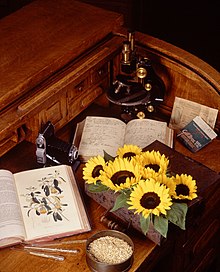Thành viên:Linh Comer/Nháp/15

Lịch sử thực vật học gồm những nỗ lực nghiên cứu của con người để hiểu về sự sống trên Trái Đất bằng cách truy vết lịch sử phát triển của phân ngành thực vật—một phần của bộ môn khoa học tự nhiên liên quan đến các sinh vật mà theo truyền thống được xem là thực vật.
Môn khoa học thực vật sơ khai bắt đầu bằng vốn hiểu biết về thực vật dựa theo kinh nghiệm, được truyền miệng từ thế hệ này qua thế hệ khác theo truyền thống của người săn bắn và hái lượm thời đồ đá cũ. Những ghi chép đầu tiên về thực vật ra đời trong cuộc cách mạng đồ đá mới khoảng 10.000 năm về trước, lúc mà chữ viết được phát triển ở các cộng đồng định cư nông nghiệp, nơi con người lần đầu thuần hóa thực vật và động vật. Những ghi chép đầu tiên cho thấy trí tò mò của con người về chính thực vật hơn là các công dụng nà chúng đem lại, xuất hiện ở thời Hy Lạp cổ đại và Ấn Độ cổ đại. Ở Hy Lạp cổ đại, những bài giảng của Theophrastus (học trò của Aristoteles) tại Lyceum ở Athens cổ đại khoảng 350 trước Công Nguyên (TCN) được xem là điểm khởi đầu cho nền thực vật học phương Tây. Ở Ấn Độ cổ đại, Vŗkşăyurvĕda (còn gọi là Parăśara) cũng được xem là một trong những văn bản ra đời sớm nhất miêu tả nhiều phân ngành của thực vật học.[1]
In Europe, botanical science was soon overshadowed by a medieval preoccupation with the medicinal properties of plants that lasted more than 1000 years. During this time, the medicinal works of classical antiquity were reproduced in manuscripts and books called herbals. In China and the Arab world, the Greco-Roman work on medicinal plants was preserved and extended.
In Europe the Renaissance of the 14th–17th centuries heralded a scientific revival during which botany gradually emerged from natural history as an independent science, distinct from medicine and agriculture. Herbals were replaced by floras: books that described the native plants of local regions. The invention of the microscope stimulated the study of plant anatomy, and the first carefully designed experiments in plant physiology were performed. With the expansion of trade and exploration beyond Europe, the many new plants being discovered were subjected to an increasingly rigorous process of naming, description, and classification.
Progressively more sophisticated scientific technology has aided the development of contemporary botanical offshoots in the plant sciences, ranging from the applied fields of economic botany (notably agriculture, horticulture and forestry), to the detailed examination of the structure and function of plants and their interaction with the environment over many scales from the large-scale global significance of vegetation and plant communities (biogeography and ecology) through to the small scale of subjects like cell theory, molecular biology and plant biochemistry.